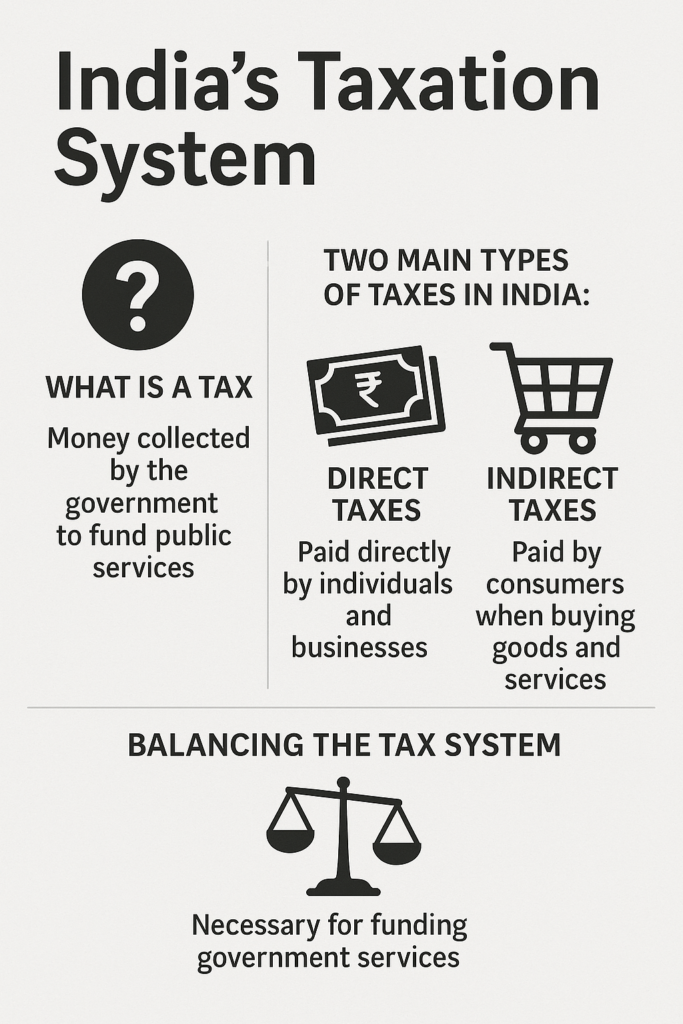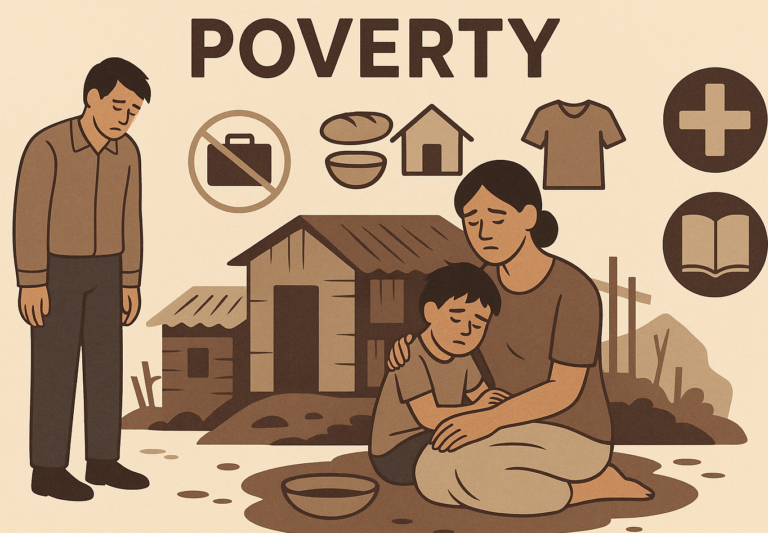India’s Taxation System, the difference between Direct and Indirect Taxes, and how they impact people and the economy in a simple and easy-to-understand way.

1. What is a Tax?
A tax is money that the government collects from people and businesses to fund public services like education, healthcare, infrastructure, and defense. Taxes help the government run the country and provide essential services.
There are two main types of taxes in India:
- Direct Taxes
- Indirect Taxes
2. Direct Taxes
Direct taxes are taxes that are directly paid by individuals or businesses to the government. These taxes are levied on income or wealth.
Examples of Direct Taxes:
- Income Tax: This is a tax paid by individuals based on their income. For example, if someone earns ₹5,00,000 a year, they will pay a certain percentage of that as income tax based on the tax rates set by the government.
- Corporate Tax: Businesses have to pay tax on their profits. If a company makes a profit, they have to pay tax on that profit.
- Wealth Tax: This is charged on the value of an individual’s wealth, like property and other assets, though this tax has been abolished in India.
How Direct Taxes Work:
- The Person Pays Directly: If you earn income, the government directly collects the tax from you based on how much you earn.
- Tax Slabs: In India, income tax is based on slabs (different ranges of income). The more you earn, the higher the percentage of income tax you pay. For example:
- Up to ₹2.5 lakh – No tax
- ₹2.5 lakh to ₹5 lakh – 5% tax
- ₹5 lakh to ₹10 lakh – 20% tax
- Above ₹10 lakh – 30% tax
Impact of Direct Taxes:
- Redistribution of Wealth: Direct taxes help redistribute wealth because they are progressive. People who earn more pay more tax, helping fund government programs for poorer sections of society.
- Incentives: Direct taxes can encourage people to save and invest in tax-saving schemes to reduce their taxable income.
- Accountability: People can see how much tax they pay, so they can hold the government accountable for how the tax money is used.
3. Indirect Taxes
Indirect taxes are taxes that are not directly paid by individuals to the government. Instead, businesses collect these taxes from customers when they sell goods and services. The business then passes on this collected tax to the government.
Examples of Indirect Taxes:
- Goods and Services Tax (GST): GST is a single tax that applies to the sale of goods and services in India. It’s added to the price of products or services. For example, when you buy a product, the price includes GST (such as 18% for most goods).
- Excise Duty: This tax is charged on specific goods like alcohol, tobacco, and petroleum products.
- Customs Duty: This tax is charged on goods imported into India, like electronics or cars from other countries.
How Indirect Taxes Work:
- The Consumer Pays: When you buy a product, the business adds the tax to the price. For example, if a shirt costs ₹500 and there is 18% GST, you pay ₹590, with ₹90 going to the government.
- Hidden Taxes: Indirect taxes are often not visible to consumers because they are included in the price of goods or services.
Impact of Indirect Taxes:
- Wider Coverage: Indirect taxes apply to everyone who buys goods or services, so even people who don’t earn much pay these taxes when they make purchases.
- Price Increase: Since businesses pass on the cost of the tax to consumers, the price of goods and services can increase. This can lead to inflation, especially when taxes on essential items like food and fuel rise.
- Regressive Nature: Indirect taxes can be regressive, meaning they affect lower-income people more. For example, a poor person and a rich person both pay the same tax on the same item, but the poor person spends a larger percentage of their income on these goods.
4. Key Differences Between Direct and Indirect Taxes
| Feature | Direct Taxes | Indirect Taxes |
|---|---|---|
| Who Pays? | Paid directly by the individual or business (e.g., income tax, corporate tax) | Paid by the consumer when they buy goods or services (e.g., GST, excise duty) |
| Taxpayer | Individuals and businesses pay directly to the government | Businesses collect the tax from consumers and pass it to the government |
| Tax Burden | Tax burden depends on income or wealth (progressive) | Tax burden is the same for all consumers who buy the product, regardless of income (regressive) |
| Examples | Income Tax, Corporate Tax, Wealth Tax | GST, Excise Duty, Customs Duty |
| Visibility | Visible to the taxpayer (can see how much tax is paid) | Hidden in the price of goods or services (consumers may not know exact tax paid) |
| Impact | Affects people based on their income or wealth | Affects everyone who purchases goods/services |
5. Impact of Taxation on the Economy
Taxes play a significant role in the economy and can have both positive and negative effects:
Positive Impacts:
- Government Revenue: Taxes are the main source of income for the government, enabling it to fund important public services like healthcare, education, and infrastructure.
- Economic Development: Taxes are used to build roads, bridges, schools, and hospitals, which help in the development of the economy.
- Social Welfare: Direct taxes like income tax can be used to fund programs that help the poor and disadvantaged sections of society.
Negative Impacts:
- Inflation: High taxes on goods and services (like GST) can increase the price of everyday items, leading to higher living costs for consumers.
- Tax Evasion: Some people or businesses may try to avoid paying taxes by hiding their income or activities, which can reduce government revenue.
- Incentives to Save: High direct taxes on income may discourage some people from earning more or investing because they know a large part of their income will be taxed.
6. Conclusion
- Direct Taxes are paid directly by individuals and businesses based on their income or wealth. These taxes are progressive and help redistribute wealth.
- Indirect Taxes are paid by consumers when they buy goods and services. These taxes are regressive, meaning they affect people with lower incomes more.
Both types of taxes are necessary for the government to function and fund essential services. However, there is a balance that needs to be maintained to ensure that taxes do not burden people too much while still providing the government with enough funds to invest in the country’s development.











